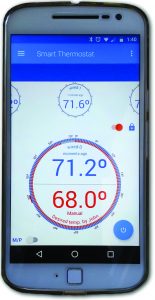by Pat Keegan and Brad Thiessen
 Today, many thermostats offer great new technologies and can do things thermostats of the past simply could not do. That said, it’s certainly worth asking if these new thermostats can save enough money to justify the extra cost.
Today, many thermostats offer great new technologies and can do things thermostats of the past simply could not do. That said, it’s certainly worth asking if these new thermostats can save enough money to justify the extra cost.
Let’s start by looking at the three main options for thermostats: manual, programmable and smart.
The main benefits of a manual thermostat are that it’s simple to operate and there are no batteries to wear out and replace. You just have to remember to raise and lower the temperature setting in the morning and evening, and whenever you leave the house.
The second option is the programmable thermostat. Typically, this type of thermostat allows settings for four different periods each day. Some models can even handle a different schedule for each day of the week. You control the settings so they will suit your climate, schedule and temperature preferences.
The third option is a smart, or “learning” thermostat. A smart thermostat connects to your home’s Wi-Fi network. After installation, you input the basics of your schedule and temperature. Over time, as you change the settings, it learns your schedule and adjusts to minimize energy use. Smart thermostats can also detect when no one is home. You can also control it remotely by using an app on your smartphone or tablet.
If your electric co-op has a demand response program that offers discounts for using less power during peak energy use hours, a smart thermostat can provide additional savings on your monthly power bill.
The move to smart technology is a significant investment. Units can cost up to $400, although one manufacturer has a new model for about $170. It’s also important to note not all homes have the proper wiring in place to accommodate smart thermostats, so you may need to hire a professional to handle the installation.
Are newer, more expensive thermostats worth the extra cost? How much a thermostat can save depends on how much you spend on heating and cooling your house.
You can estimate your heating and cooling expenses by examining your electric bills (and other utility bills) related to heating your home. Compare the bills for winter and summer to those for spring and fall. Most of the difference is likely due to heating and cooling. If that amount is more than $900 per year, which is the national average, you have a better chance of a good return on your investment.
The second factor that will determine how much you can save is how you are operating your old thermostat. If you are conscientious about adjusting the temperature to save energy when you’re leaving the house or going to bed, the new thermostat may not reduce your bills that much, even if you program it correctly or if it learns your behavior.
As you make your decision, don’t forget to look to your electric co-op’s website for advice, ratings and maybe even rebates.
This column was co-written by Pat Keegan and Brad Thiessen of Collaborative Efficiency. For more ideas on energy efficiency, please visit: www.collaborativeefficiency.com/energytips.



